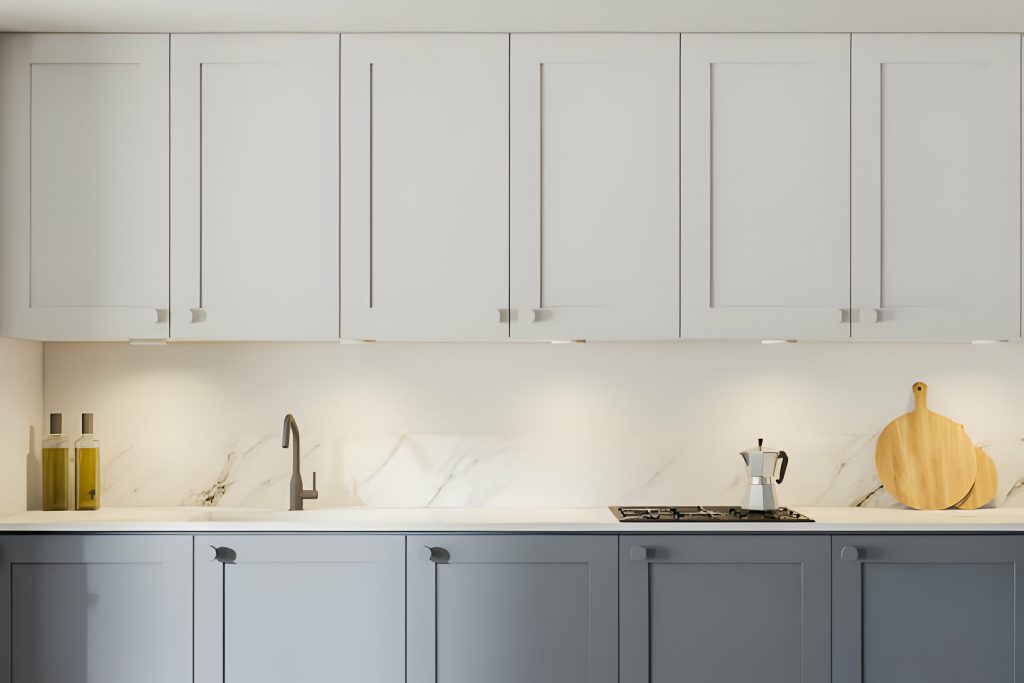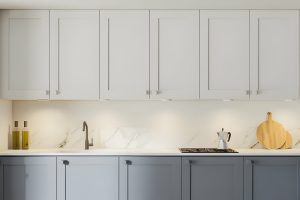Are your wood kitchen cabinet doors in need of a good cleaning? Don’t worry, we’ve got you covered! In this article, we will guide you through the steps to achieve sparkling clean cabinet doors. Gather your supplies, remove the hardware, and dust thoroughly. Then, mix up a homemade cleaning solution and apply it to your cabinets. Rinse and dry, and voila! Your wood kitchen cabinet doors will be looking brand new in no time.
Gather Necessary Supplies
To gather the necessary supplies, you will need a few common household cleaning products. When it comes to cleaning wood kitchen cabinet doors, it’s important to have the right tools on hand. Firstly, you will need a soft microfiber cloth. This cloth is gentle enough to clean the wood surface without scratching or damaging it. Additionally, a mild dish soap or wood cleaner is essential to remove any grease or grime buildup. Avoid using harsh chemicals or abrasive cleaners, as they can strip away the protective finish on the cabinet doors.
In order to protect the cabinet finish during the cleaning process, it is recommended to use a furniture polish or cabinet conditioner. These products will help to restore moisture to the wood and keep it looking its best. It’s important to read the labels and choose a product that is specifically formulated for wood cabinets.
In terms of cleaning technique, start by dampening the microfiber cloth with water and a small amount of dish soap or wood cleaner. Gently wipe down the cabinet doors, paying close attention to any areas that may be particularly dirty or sticky. Rinse the cloth frequently to avoid spreading dirt around. Once the doors are clean, use a separate cloth to apply the furniture polish or cabinet conditioner, following the manufacturer’s instructions. This will help to restore shine and protect the wood surface.
Remove Cabinet Hardware
To remove cabinet hardware, start by gathering a screwdriver and any other necessary tools. This step is important because it ensures you have the right equipment to safely remove the hardware without causing any damage. Before beginning, make sure to take note of the type of hardware you have, as different types may require different removal techniques. For example, some cabinet knobs may be attached with screws, while others may have a decorative cover that needs to be lifted before accessing the screw.
Once you have the necessary tools, begin by removing the screws that hold the hardware in place. Use the screwdriver to carefully unscrew the screws, making sure to keep them in a safe place so they don’t get lost. After removing the screws, gently pull the hardware away from the cabinet. If there is any resistance, double-check to ensure all screws have been removed.
When cleaning cabinet hardware, it’s important to choose the right products and techniques to avoid damaging the material. For metal hardware, such as brass or stainless steel, you can use a mild dish soap and warm water solution to remove any dirt or grease. For wooden hardware, avoid using water altogether, as it can cause warping or discoloration. Instead, use a wood-specific cleaner or a mixture of vinegar and water to gently clean the surface.
Dust Cabinets Thoroughly
To properly clean wood kitchen cabinet doors, it is important to follow the right techniques. Start by thoroughly dusting the cabinets using a soft cloth or microfiber duster to remove any loose debris. Be sure to choose the right cleaning products that are safe for wood surfaces to avoid damaging the cabinets. Additionally, to prevent future dust buildup, consider using furniture polish or a wood conditioner to keep the cabinets looking clean and polished.
Proper Cleaning Techniques
Start by thoroughly dusting your wood kitchen cabinet doors using a microfiber cloth or a soft brush. Dusting is an essential step in the proper cleaning of wood cabinets as it removes loose dirt, debris, and allergens. To ensure effective cleaning, make sure to reach all the corners, crevices, and edges of the doors. This will help prevent the accumulation of dust and grime over time. In addition to regular dusting, it is important to address stubborn stains on your wood cabinet doors. For this, you can use a mild dish soap mixed with warm water. Gently scrub the stained area using a soft cloth or sponge. Rinse with clean water and dry thoroughly. For more stubborn stains, you may need to use a specialized wood cleaner or a mixture of vinegar and water. Remember to always test any cleaning solution on a small, inconspicuous area first to ensure it does not damage the wood finish.
Choosing the Right Products
Make sure you have the proper products on hand to thoroughly dust your cabinets. When it comes to cleaning wood kitchen cabinet doors, it’s important to choose the right products that will effectively remove dust without damaging the wood. There are a variety of wood cleaning products available on the market that are specifically designed for this purpose. Look for products that are labeled safe for use on wood surfaces. These products often contain gentle cleansers and conditioners that will help to preserve the natural beauty of your cabinets. However, if you prefer to use natural cleaning methods, there are also homemade solutions you can try. For example, a mixture of vinegar and water can be used to make an effective wood cleaner. Simply mix equal parts vinegar and water in a spray bottle and use it to wipe down your cabinets. Remember to always test any cleaning product on a small, inconspicuous area of your cabinets before using it on the entire surface.
Preventing Future Dust Buildup
After thoroughly dusting your wood kitchen cabinet doors, prevent future dust buildup by regularly cleaning and maintaining them. Here are some tips to help you keep your cabinets dust-free:
- Perform regular maintenance by wiping down the cabinet doors with a soft, damp cloth. This will remove any dust or dirt that may have accumulated.
- Use a mild, non-abrasive cleaner specifically designed for wood surfaces to clean the cabinets. Avoid using harsh chemicals that can damage the wood.
- Apply a protective coating, such as wax or polish, to the cabinet doors. This will help repel dust and keep the wood looking shiny and new.
- Consider installing door sweeps or weather stripping to prevent dust from entering the cabinet space.
- Keep the surrounding area clean and free of dust. Regularly vacuum or sweep the floor and wipe down any nearby surfaces to minimize dust particles in the air.
Mix Homemade Cleaning Solution
First, gather the necessary ingredients to create your homemade cleaning solution for your wood kitchen cabinet doors. Using natural cleaning alternatives has many benefits, such as avoiding harsh chemicals and reducing environmental impact. Homemade cleaners are not only effective but also cost-effective. To make your own cleaning solution, you will need white vinegar, water, and a few drops of essential oil (optional). White vinegar is a great natural cleaner that helps remove grease, grime, and dirt from wood surfaces. The acidity of vinegar also helps to kill bacteria and eliminate odors. Mix equal parts of white vinegar and water in a spray bottle. If desired, add a few drops of essential oil for a pleasant scent. Shake the bottle to ensure the ingredients are well mixed. Your homemade cleaning solution is now ready to use.
Apply Cleaning Solution to Cabinets
Spray the cleaning solution onto your wood kitchen cabinet doors. This step is crucial for effectively removing dirt, grease, and grime from the surface of the cabinets. The cleaning solution will help to break down any stubborn stains and leave your cabinets looking fresh and clean.
To ensure the best results, consider using natural cleaning methods or cleaning solution alternatives. These options are not only effective at removing dirt but also safe for the environment and your health. Here are five alternatives you can try:
- Vinegar and water: Mix equal parts vinegar and water in a spray bottle for an all-purpose cleaner.
- Baking soda paste: Create a paste by mixing baking soda with water, then apply it to stubborn stains.
- Lemon juice: Cut a lemon in half and use it to scrub away grease and grime.
- Olive oil: Apply a small amount of olive oil to a soft cloth and use it to polish and shine your cabinets.
- Castile soap: Mix a few drops of castile soap with warm water to create a gentle cleaning solution.
Remember to test the cleaning solution on a small, inconspicuous area of your cabinets before applying it to the entire surface. This will ensure that the solution does not cause any damage or discoloration.
Rinse and Dry Cabinets
Now that you have finished rinsing off the cleaning solution from your wood kitchen cabinet doors, it is crucial to properly dry them to prevent any water damage. To ensure a thorough drying process, use a clean and dry microfiber cloth or towel to gently wipe down the surfaces. Pay extra attention to any crevices or corners where water may have accumulated. Properly drying your cabinets will not only maintain their appearance but also prolong their lifespan.
Proper Drying Techniques
To dry your wood kitchen cabinet doors properly after rinsing, gently wipe them with a clean, soft cloth. This step is crucial to prevent any water spots or streaks from forming on the surface of the wood. After wiping them down, it’s important to let the doors air dry completely before closing them. Here are some additional drying techniques to consider:
- Use a fan or open windows to promote air circulation and speed up the drying process.
- Avoid using excessive heat sources like hairdryers, as they can cause the wood to warp or crack.
- If your cabinet doors have intricate designs or crevices, use a microfiber cloth or a soft brush to ensure that all moisture is removed.
- Check for any remaining moisture by running your hand over the surface of the doors. If they feel damp, continue to let them air dry.
- Once the doors are completely dry, you can proceed with any further maintenance or treatments.
Preventing Water Damage
To prevent water damage, you should thoroughly rinse and dry your wood kitchen cabinet doors. After cleaning the doors with a mild detergent solution or a mixture of vinegar and water, it is crucial to rinse them thoroughly to remove any residue. Use a clean, damp cloth or sponge to wipe away the cleaning solution. Make sure to wring out the cloth or sponge well to avoid excessive moisture. After rinsing, use a dry cloth or towel to completely dry the cabinet doors. This step is essential as excess water left on the wood surface can lead to warping, swelling, or even mold growth. By preventing water damage through proper rinsing and drying techniques, you can prolong the life of your wood kitchen cabinet doors and maintain their beauty. Remember to always avoid harsh chemicals and abrasive materials to prevent scratches and damage to the wood.





